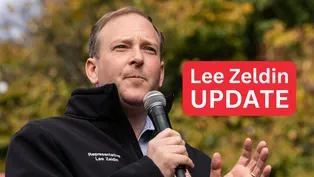
Inside Look at the Historic NY State Capitol Building
Clip: Season 2023 Episode 6 | 7m 24sVideo has Closed Captions
Join us for a tour of the historic New York State Capitol building.
Take a unique virtual tour of the New York State Capitol building. Get an inside look at one of the most historic buildings in New York and learn about its rich history and significance.
Problems with Closed Captions? Closed Captioning Feedback
Problems with Closed Captions? Closed Captioning Feedback
New York NOW is a local public television program presented by WMHT
Support for New York NOW is provided by WNET/Thirteen and New York State AFL-CIO.

Inside Look at the Historic NY State Capitol Building
Clip: Season 2023 Episode 6 | 7m 24sVideo has Closed Captions
Take a unique virtual tour of the New York State Capitol building. Get an inside look at one of the most historic buildings in New York and learn about its rich history and significance.
Problems with Closed Captions? Closed Captioning Feedback
How to Watch New York NOW
New York NOW is available to stream on pbs.org and the free PBS App, available on iPhone, Apple TV, Android TV, Android smartphones, Amazon Fire TV, Amazon Fire Tablet, Roku, Samsung Smart TV, and Vizio.
Providing Support for PBS.org
Learn Moreabout PBS online sponsorship- We show you a lot of the State Capitol on this show, and if you've never been there, I promise it is well worth the trip.
The State Capitol took more than three decades to build and even then it wasn't done when then Governor Teddy Roosevelt took office, he stopped work on the Capitol and declared it finished.
And since then, a lot of the building has been preserved with original floors, walls, and staircases that all still look brand new.
So this week we thought we'd take you on your own trip to the State Capitol and this piece from WMHT's Will Pedago - 2:00 PM tour.
You guys made it.
Welcome, welcome everyone.
Welcome to Albany.
We're gonna take the next 45, 50 minutes, nice, leisurely walk through the Capitol, all right, follow me.
My name is Matt and I have been a tour guide since August 27th, 2012.
We're gonna fill up this elevator.
I assure you that we can probably all fit in here, all right.
I feel unbelievably lucky, because we get to talk about New York state history.
We get to talk about culture we get to talk about art every day.
I could not imagine that a job like this would exist, but it does.
A couple steps down, feel free to take a seat.
You're already taking photographs, this is what I want to see.
New York spent a lot of money on the Civil War, right?
More money than any state.
We provided more guns, more bullets, more everything toward the cause and more New Yorkers died fighting in the Civil War than any state.
So we come out of the war victorious.
We want to celebrate, we want to memorialize the situation right?
The history.
Well, we chose to build a new capitol.
Our tour guides, not only do they need to know the ins and outs of the building and what type of stone is behind me, but they also need to know where any visitors are supposed to go for whatever needs they have that day.
Our detail gets extremely granular.
Lucky for us, we found some of the last original tile floor in the building under some 1950s floor and this is Minton Tile from the Minton China company out of England.
Since they are still around if one of the tiles here cracks or breaks they can make us a replica of a tile that they made us over a hundred years ago.
How amazing is that?
All right, follow me.
We can thank the OGS design and construction crew, who have done reports on the building.
There are historic reports, architecture reports that tell us how many windows there are how many columns, how many arches, each stone, each tile what was really original, what was replica, what's not, and we need that information because we get those questions every day from visitors.
- [Visitor] Was this the first building to have electricity in Albany?
- This was one of the first government buildings in the country with electric lighting.
The New York State Capitol is extremely complicated right?
Right off the bat it has has to do with the architects.
You know, usually you have one architect they come up with one single beautiful design and they roll it out and there's a completion date.
But for our Capitol, it did not work out that way, right?
We had five architects in total, we have about five to six different architectural styles within the building.
Architects didn't agree with what the previous architect might have done.
We talk about Henry Hobson Richardson being the main architect for the Senate side of the building, but he never touched the Senate staircase, it was his architectural partner, Leopold Eidlitz who did something completely different.
I mean, it is so complicated, but if anything it makes it really, really interesting and exciting, and I think that's really why visitors are drawn, and I mean, there was someone on the tour today that I know has taken our tour probably five or six times.
All right, this is it.
This is the New York State Assembly Chamber, right?
We need both chambers in order to get those bills voted on right?
Majority vote yes, and to the governor's desk for a signature.
I love New York State.
and so my background is in geography, and my specialty was New York State geography.
Yeah just an obsession of New York on the map of obsession of everything within that map.
Landmarks, cities, towns, historic events.
You know, the majority of the American Revolution was fought on New York state soil, that's amazing.
You know, like New York really is a special place as far as national history.
This is what we call the Great Western Staircase.
This staircase took about 12 years to build.
Every bit of the stone was imported from Scotland.
It's a sandstone.
It was ideal for carving.
It was covered in hay to keep it moist on its transport here to Albany.
Once it arrived, the blocks were set and the carvers got onto the stone and carved in place.
The Great Western Staircase, the public knows it as the Million Dollar Staircase, I think that's the perfect representation.
It might be one type of architecture but there are 77 famous faces and many of them are New Yorkers, and they are all diverse backgrounds, right?
You have women, you have plenty of famous men, right?
But you know, we have Frederick Douglass we have Susan B. Anthony, we have these figures in history that just remind visitors of how important our American history is.
If anything, this staircase is really that.
It's a showcase of American history, right?
Not just New York state history but really New York's involvement in national history.
The response we want from visitors who take our tours and see our exhibits, it's really that they walked away learning something, really anything even if it was 10%, 1% that they got, at least they were learning something about New York state, something that matters.
On the Capitol tourist side, you know, my main goal is to let people know that this is a public building.
You know, this is not some fortress that you're not allowed to enter, and I think there's a major misnomer of people thinking that they can't come into this building.
You know, you walk in and you see a security guard, and you see metal detectors, and I think sometimes people won't even ask if they could go any further.
They'll just see that and just turn around and leave, and that is absolutely not what people should do.
You know, just come inside, it's open to the public, get through the metal detector and you can roam the halls.
Take pictures of some of the most beautiful architecture that you will ever see, I mean it's here.
Also letting people know that they can become part of the legislative process.
When New Yorkers take our tours and they did not know that they can watch a legislative session live, or know that they can even be involved in that process, there's a message being lost there, and so our tour guides really try to remind the public that this is an accessible building and the work that's happening in this building will affect your life, and if you choose not to be involved, that's your choice, but there are consequences to choices.
Assembly Speaker Carl Heastie on Gov. Hochul's Budget
Video has Closed Captions
NY Assembly Speaker Carl Heastie on legislative session & Hochul's budget plan. (15m 20s)
Home Care Workers' Fight for Fair Wages
Video has Closed Captions
Home care workers push for higher pay, which is not included in Hochul's budget plan. (56s)
Is Lee Zeldin Running for U.S. Senate?
Video has Closed Captions
Former Congressman Lee Zeldin speaks about his political future. (53s)
Providing Support for PBS.org
Learn Moreabout PBS online sponsorshipSupport for PBS provided by:
New York NOW is a local public television program presented by WMHT
Support for New York NOW is provided by WNET/Thirteen and New York State AFL-CIO.














